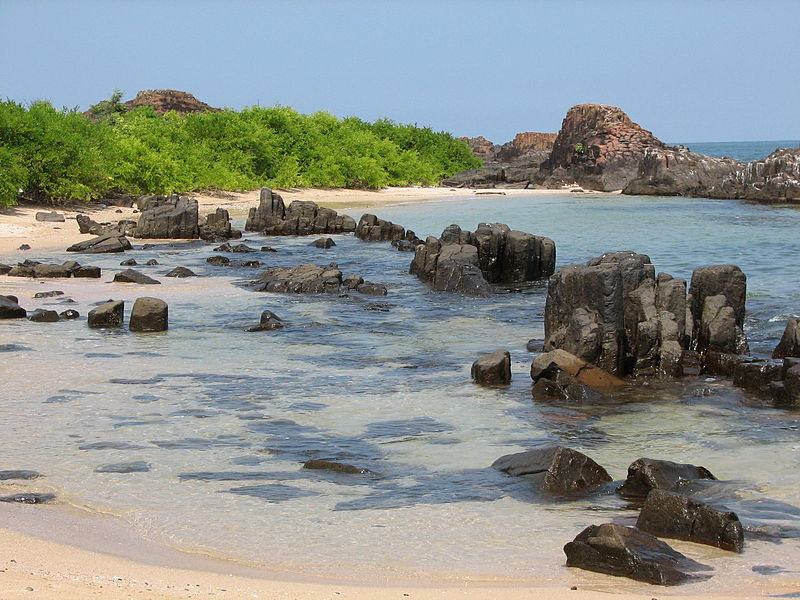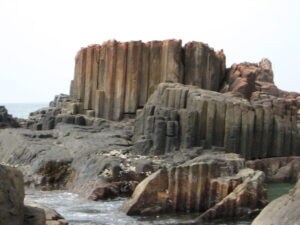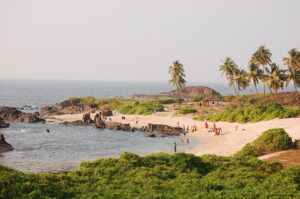Exploring the monoliths of St Mary’s Island

St Mary's island has no inhabitants and is bereft of any hawkers, food joints or any other commercial venture (Photo Credits: Amandeep)
Numerous rock monoliths make St Mary’s Island, a quaint island just off the coast at Udupi in Karnataka, great ecological wonder and a mesmerising place to be in. About 7 km into the Arabian Sea, the island is a geological treasure and hosts some of the most beautiful beaches in the country.
“Crystal clear waters of the sea gently caress your feet as you sit on the soft white sands of the beach underneath the shade of a swaying palm tree, and all you can hear is the gentle sound of the waves. The enchanting environs of St Mary’s Island, which is uninhabited, has retained their pure and enchanting form. The beach was indeed one of the best beaches that I have visited in Karnataka,” says Nilabh Krishna, a 34-year-old engineer based in Delhi who visited the island about a month ago.
The island actually is a group of four small islands namely Coconut Island, North Island, South Island and Daryabahadurgarh Island. On these islands, one can find a shoreline made up full of crystalline rocks which, according to the geologists, were created at the time Madagascar Island got separated from India, about 88 million years ago.
“It is a perfect place to plan a one-day trip near Mangalore, especially if you are a nature admirer. Watching the sunset standing on the crystalline rocks is a must-have experience,” says Krishna.
According to a popular local legend, this place was discovered by Vasco De Gama in 1498, before he reached Kozhikode, then Calicut. Gama called the islands – El Padron de Santa Maria, as per the information available on the board that welcomes tourists to the serene place.
A soon as one gets down from the ferry, usually coming from the Malpe harbour in the neighbourhood Udupi town, tourists are greeted with a wooden board with a ‘Welcome to St Mary’s Island’ written on it. The guides at the entrance ensure that no plastic and food items are carried to the island.
Contrary to most other beaches in the country with endless stretches of golden sand, St Mary’s Island’s rocky terrain does not encourage swimming or strolling along the shores. One can only gaze around and marvel at the idiosyncrasies of the expansive rock formations strewn around the beach.
Its shore also remains littered with seashells of various shapes and sizes. “One can see thousands of beautiful shells on the beach with almost no sand on the coastline. That was a new beach experience for me,” Krishna explains.
The island has no inhabitants and is bereft of any hawkers, food joints or any other commercial venture making it all the more alluring. It has a verdant green cover and one can see and hear different birds basking luxuriously in this green utopia. For a quick break from the activities, plenty of small pavilions are available on the islands where people can rest in shade.
The island is also popular for its rock formations especially for the rectangular or what the geologists called columnar joints. The uniqueness of these islands lies in the fact that the lava oozed out millions of years ago from the cracks in the limestone, forming rocks of a polygonal shape. Normally, one would expect molten lava to have random shaped patterns after cooling but what makes them form a regular five, six or seven-sided pillar remains a scientific mystery. Geologists call this flow ‘laminar lava.’ Occurring in varying heights all over the islands, the tallest of the rocks is around six metres high. Considering their importance, the Geological Survey of India has accorded these islands the status of a National Geological Monument.
“These are perfect locations for a great photo-shoot experience. However, one must be aware of the rocks while climbing or walking on it as they are slippery,” says Amandeep, a friend of Krishna, who also visited the place.
“Crabs are also abundant on the shore and one needs to be cautious in order to avoid stepping on them,” he warns.
Those seeking an adrenaline rush can go jet skiing, try the banana boat ride or go zorbing, rolling downhill in a bubble. Treks on different trails are also organised. On the Basalt Rock Trail, tourists are taken to Boulder Beach and Seashell Beach on the island. A flora and fauna Trail is also available. Cycling trails and daytime camping facilities is available too











